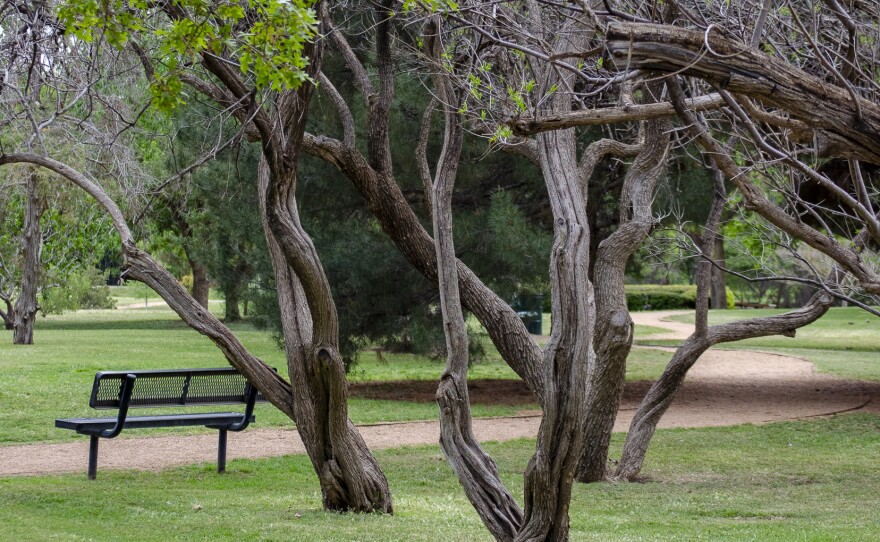For the most part, trees are not native to the High Plains area.
The variable climate, alkaline soil, dry winters, and need for irrigation makes Lubbock a difficult place in which to grow trees, according to John Wallis, president of the Lubbock Memorial Arboretum Foundation.
The Lubbock Memorial Arboretum was founded in the early 1960s, with the goal of providing horticultural education and a place for folks in Lubbock to enjoy trees. Wallis said there was a time it was the only arboretum between Fort Worth and Albuquerque.
With land leased from the city and the Parks and Recreation Department providing water and basic maintenance, nearly all of the planting in the Arboretum is done by the Arboretum Foundation. The nonprofit currently has no employees and is run entirely by volunteers. Funding comes from donations, memorial trees and benches, and from grants.
The Arboretum includes seven acres of land inside the fenced area, as well as the surrounding area outside the fence.
Wallis estimates there are more than 120 varieties of trees on the land.
Part of the Arboretum’s mission is experimenting with plants, to see how they survive in Lubbock. And then sharing that information with others interested in growing and landscaping.
Wallis says that Lubbock’s climate and soil are more similar to that of Eastern New Mexico than to many other areas in Texas, which means trees like the desert willow do quite well. Though, Lubbock presents some unique challenges.
“Every year in Lubbock is different. You can't go by what's happened in the past because the environmental factors will be different in the future,” Wallis said.
From fruit trees and coffee trees, to pecan and pistachio trees, the Arboretum’s experimentation has brought plants from all over the world into Lubbock. Including the Japanese pagoda tree, which is actually native to China; the magnolia tree, which is better suited for the climate of Mississippi; African pines; Tatarian maple trees; and the Saharan cypress, which Wallis said is endangered in its native Algeria and Morocco.
Some trees more familiar to Texans include the Mexican Buckeye, which is native to other parts of the state, and the Siberian Elm, which were commonly planted in West Texas during the Great Depression.
In addition to trees, the Arboretum has flowers– like marigolds in the star garden, California poppies in a plot that was once a casting pond for people to practice fishing, bluebonnets in the Sensory Garden– and other native plants brought in partnership with the Texas Master Naturalist program.
Another one of the Arboretum’s partners is the Lubbock Master Gardener Association, or LMGA.
The Arboretum provides a physical location for LMGA and in return, the gardeners provide resources and volunteers, Wallis explained.
Lubbock Master Gardener Association is a volunteer nonprofit and affiliate with Texas A&M AgriLife Extension Service. According to LMGA president Becky Miller, it was established in the early-1990s, with a similar mission to the Arboretum: horticultural education.
The most recent collaboration between the organizations, with contributions from the city of Lubbock and the High Plains Water District, is a demonstration garden.
“Similar to what the Arboretum does to demonstrate what trees might grow, we demonstrate different growing methods,” Miller said. “It's an experiment. Some of our demonstrations demonstrate that it doesn't work. And then some of our demonstrations demonstrate how well things work.”
The demonstration garden opened last summer. It includes different gardening areas and techniques, rain barrels, and a birdhouse for purple martins.
LMGA has free programs open to the public the third Saturday of each month, to teach people about various gardening topics. And the Arboretum has free educational presentations on the second Saturday of the month.
The Arboretum also opened a community garden last year, where people can rent a plot of about 154 square feet for $100 a year, with water provided and advice available.
Wallis stressed that for the Arboretum to continue to exist, it requires support. He said people can come out to help and learn whenever there are other volunteers working on the grounds. The Arboretum Foundation can provide tools and supervision and volunteer times are available on VolunteerLubbock.org.
Miller says becoming a Lubbock Master Gardener requires 50 hours of volunteer service and 50 hours of classroom instruction, over the course of a year, which includes online and in-person formatting.
The Lubbock Memorial Arboretum is located at 4111 University Ave.
Photos by Olivia O'Rand.


















